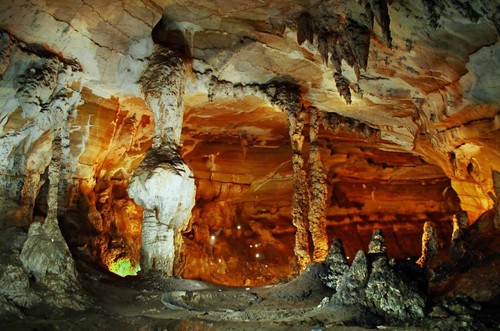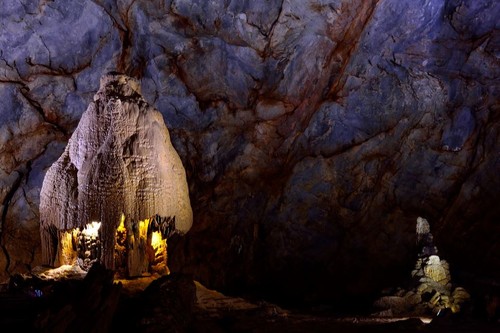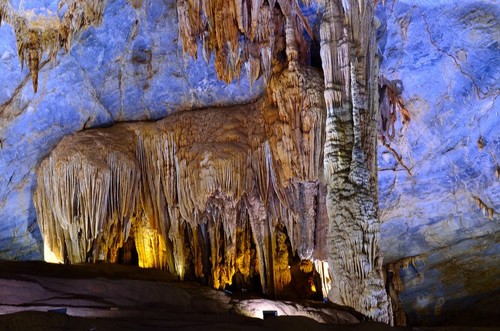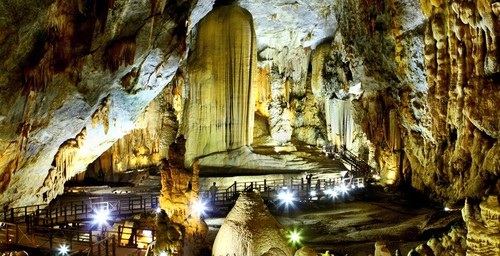(VOVworld)- Phong Nha Ke Bang national park in Quang Binh province was recognized as a World Natural Heritage Site by UNESCO in 2003 for its significant geological and geomorphic features. The site has been nominated for a second UNESCO recognition as a World Natural Heritage Site for its rich biodiversity.
A karst formation covers makes up the two thirds of the 200,000 ha area of Phong Nha-Ke Bang National Park. A system of big and small grottoes and caves and 300 km of rivers make the site one of world’s best representatives of geomorphic evolution.
 |
 |
Phong Nha Ke Bang’s huge limestone mountains contain some of the most beautiful caves and grottoes in the world. Its 300 big and small caves make it the Kingdom of caves and grottoes, where visitors have an opportunity to admire a subterranean world of stalactites and stalagmites of diverse shapes and colors. According to British Royal explorers, Phong Nha has Vietnam’s most beautiful underground river, a high, wide entrance, a beautiful sandy floor, beautiful lakes, dry caves, magnificent stalactites and stalagmites and Vietnam’s longest water cave. Many articles and photo collections on Phong Nha have been published and the site has been the subject of research in 14 universities in Europe. Do Thu Hong is a tourist from Hanoi: “We visited the site in the summer. It was very hot then in the central region. But when we visited Phong Nha Ke Bang, it was very cool. The water in the Son river was pure and we could see the bottom through the water. The landscape setting of river and mountain was very beautiful. I felt very relaxed there. We visited the Co Tien (Fairy), Cung Dinh (Palace) and Bi Ky (Mysterious) caves.
 |
Called the underground royal palace, Thien Duong (Paradise) Cave is one of the world’s great wonders, a must-see on any tour of Phong Nha Ke Bang. Through a small entrance, visitors step into in a place which is as beautiful as paradise on earth. Martin Holroyd, a British cave expert, says that cave ranking should include Thien Duong. It is an outstanding masterpiece of nature. Thien Duong cave dazzles tourists with fantastically-shaped stalactites and stalagmites. Tran Anh Quan once visited Phong Nha Ke Bang: “In Thien Duong cave, as I descended the wooden stairs to the cave. I was struck speechless by the magnificent beauty of the cave. Stalactites and stalagmites are created by nature but they resemble Rong stilt houses, Cham towers, phoenixes and the Goddess. Stalactites and stalagmites in Thien Duong cave have more diverse shapes than those in Phong Nha. I will come back to visit other caves”.
 |
In 2009, a group of researchers from the British Royal Cave Association visited Phong Nha Ke Bang and discovered Son Doong Cave, which is 200 meters wide, 150 meters high and 6.5 km long. This size surpasses Deer cave in Malaysia’s Gunung Mulu National Park as the world’s largest cave. Pike Malcolm is a British explorer: “I’m very interested in exploring Son Doong cave. It is said to be more special than Phong Nha cave. I love natural primitiveness”.
Phong Nha Ke Bang National Park is also home to Vietnam’s largest primitive forest on a limestone mountain. This is Vietnam’s leading special-use forest. The site is ideal for researchers thanks to its rich biodiversity and being home to several endemic fauna and flora species including nearly 420 endemic flora species and 30 endemic fauna species of Vietnam, 116 flora species and 166 fauna species listed in Vietnam and the world’s red books. Phong Nha Ke Bang is included in the list of Biosphere Reserves that are of Vietnam’s priority for conservation. The World Wildlife Fund includes Phong Nha Ke Bang as one of the world’s 200 centers of biodiversity. It is home to Kinh majority and Bru Van Kieu and Chut minority groups, whose culture and tradition make the site more attractive to both domestic and foreign visitors.